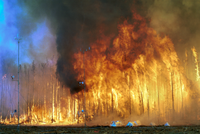-
New Florida museum is glass-covered hurricane-proof fortress

The new Salvador Dali Museum in St. Petersburg is designed to withstand category 5 hurricanes; the roof is 12-inch thick solid concrete; the walls are even thicker, at eighteen inches; the glass, which makes up big sections of the outside of the museum, can hold up to a category 3 hurricane; if that glass breaks, letting rain, wind, and debris into the facility, the art will still be safe: storm doors will shield the galleries on the third floor, and the vault, which is on the second floor (all of the art is placed on the second and third floors, above the 30-foot storm surge of a category 5 storm)
-
-
New levee design, construction materials tested in Louisiana
Since Katrina, attention has been riveted on $14 billion worth of federal projects to rebuild the deficient hurricane levee system so it can better defend from surges out of lakes Borgne and Pontchartrain; the Army Corps of Engineers plans to start experimenting with a new construction method, which relies on a mix of lime and clay to build the test levee higher without widening the levee base; this method of raising existing river levees can be done faster than a standard raising and will not require buying additional land to expand the base; mixing lime and clay and water will not produce concrete, which has a measured strength of 3,000 pounds per square inch, or psi, the mixture will have a strength of 80 to 120 psi — substantially greater than the 3 to 5 psi of a compacted clay levee
-
-
Disaster response experts call for "red-helmet brigade"
Experts say that the world need to be better prepared to respond to natural disasters such as the Pakistan floods of the Haiti earthquake; they say that an organization such as the UN Office for the Coordination of Humanitarian Affairs should establish a special response unit to set up a computerized database that identifies all available assets routinely needed in an emergency — emergency personnel, medical personnel, water, non-perishable food stuffs, extraction machinery, temporary shelters, and field hospitals; some supplies could be held in locations around the world, ready to be dispatched as soon as disaster assessment experts working for a central command and control center arrive on the scene of a catastrophe
-
-
China, Pakistan floods; Haiti earthquake: not merely "natural" disasters
The recent disasters in Pakistan, China, and Haiti have done more than kill thousands and displace millions: they have raised questions about whether the modifier “natural” — as in “natural disaster” — is accurate in describing the sources and scope of the catastrophes; these and other recent disasters, in other words, raise questions about how much of the damage caused comes from the forces of nature and how much is the result of human activity; experts say that a major contributing factor to the scope of these disasters are development decisions which are too often controlled by wealthy and corrupt elites who have no interest in protecting people who have been marginalized by poverty
-
-
Wild fires in Russia may shower region with Chernobyl-era radioactive particles

Large forested areas in Bryansk were contaminated when the Chernobyl nuclear power plant’s Reactor No. 4 exploded during a pre-dawn test on 26 April 1986, spewing radioactive clouds over much of the western Soviet Union and northern Europe; radioactive particles settled into the soil, and environmentalists have warned that they could be thrown up into the air once again by wildfires and blown into other areas by the wind; the death rate in Moscow has doubled to 700 people a day
-
-
Cholera spreads in flood-ravaged Pakistan
With stagnant water throughout Pakistan, water-borne diseases such as gastroenteritis, malaria, and typhoid, now threaten the nation; there are reports of diarrhoea and cholera among the hundreds of thousands left homeless, and food and drinking water are in short supply
-
-
Good business: Developers make buildings more disaster-secure than building code requires
A Florida developer hopes to get more business by making his building hurricane-proof; with debris-resistant windows on all thirty-five of its stories, the developer says the building would withstand a Category 5 hurricane without significant damage; the extra hurricane proofing built into the Miami building shows that sometimes the private market can overtake the public sector when it comes to building design and safety standards; for example, in New York and Washington, D.C., some developers have put in anti-terrorism safeguards that exceed building codes
-
-
Keeping trains on track
Tel Aviv University helps develop early-warning hazard system for the world’s railways; researchers are collecting high-tech sensing data from satellites, airplanes, magnetic and soil sensors, and unmanned aircraft to devise a solution that will provide a reliable early-warning system for train operators; the solution will help keep trains on track during natural disasters and acts of terrorism
-
-
25,000 new asteroids -- 95 in near Earth orbit -- found by NASA's sky mapping
NASA’s newest space telescopes has spotted 25,000 never-before-seen asteroids in just six months; 95 of those are considered near Earth objects — which means, in the language of astronomy, that they are within thirty million miles of Earth; the telescope also sighted fifteen new comets and confirmed the existence of twenty brown dwarfs — stellar objects that are bigger than a planet but much smaller than a star; the full celestial catalog of what is out there will not be released to the public until next year after NASA has had time to process the images and flag false alarms
-
-
Congress to establish a commission to study threat of asteroid impact on Earth
The annual probability of the Earth being struck by a huge asteroid or comet is small, but the consequences of such a collision are so calamitous that it is prudent to appraise the nature of the threat and prepare to deal with it, experts say; Congress agrees
-
-
DHS unveils more Than $1.8 billion in FY 2010 preparedness grants
DHS announces more than $1.8 billion in preparedness grants; the grants are designed to help states, urban areas, tribal governments, and non-profit organizations enhance their protection, prevention, response, and recovery capabilities for risks associated with potential terrorist attacks and other hazards.
-
-
New technology could lead to an earthquake prediction system
A new airborne radar-based mapping technology allows scientists to see earthquake images on the ground for the first time; the airborne images show tiny or large motions that occurred beneath the surface of the earth, on the fault line, which can not be seen by flying over an area or walking on the surface
-
-
Scientist says nuclear weapons best bet for saving Earth from asteroids
Scientists argue that the best way to prevent a large asteroid from doing grave damage to Earth is to blast the asteroid with nuclear weapons; the sheer power of a nuclear explosion may make it the most practical and cost-effective option for deflecting or fragmenting asteroids, compared with alternatives such as chemical fuel or laser beams; for one thing, a nuclear explosive would be cheaper to launch into space due to its large amount of energy per unit mass; in contrast, a non-nuclear blast might require several launches for an equivalent amount of power
-
-
Online monitors of Yorkshire flood risk
The U.K. Environment Agency now offers individuals and businesses at flood risk in Yorkshire a real-time Web-based monitoring of local river and sea levels; the data from more than 1,700 monitoring stations across England and Wales will complement personalized phone and text-message alerts from the Environment Agency’s free flood-warning service
-
-
Tiny flying robots to monitor forest-fires, chemical spills, and more
Swiss researchers developed a tiny flying robot which could be equipped with different sensors and small cameras for a variety of applications; the robot could monitor different kinds of emergencies — from forest fires to chemical accidents
-
More headlines
The long view
The Surprising Reasons Floods and Other Disasters Are Deadlier at Night
It’s not just that it’s dark and people are asleep. Urban sprawl, confirmation bias, and other factors can play a role.
Why Flash Flood Warnings Will Continue to Go Unheeded
Experts say local education and community support are key to conveying risk.
